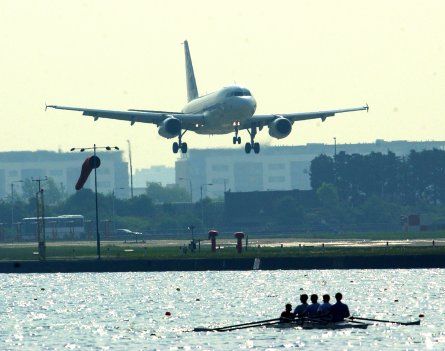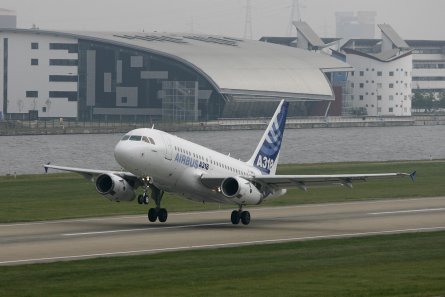|
| London City's short runway has water either side and steep approaches |
An Airbus A318 flew into London City airport for the first time on 13 May via its unusually steep instrument landing system (ILS) approach and touched down on the short 1,199m (3,650ft) runway. Approval of the twinjet would extend significantly the number of destinations reachable non-stop from the downtown airport.
London City’s ILS has a 5.5° glideslope (compared with the normal 3°) for noise abatement reasons, and this would cause most jet aircraft to arrive over the runway too fast to land.
However, Airbus has been working since August 2003 on first assessing the business case for modifying an A318 for City operations, then determining the best method of achieving it with minimal alteration from the aircraft’s standard configuration. The system was given the go-ahead by Airbus marketing in August 2004. Chief engineer for the A320 series Pierre-Henri Brousse says the A318’s steep approach system, certificated by the European Aviation Safety Agency in March, consists of a small hardware component, no changes or additions to control surfaces, and the rest done by software modifications to the aircraft’s fly-by-wire (FBW) control system. No changes are required to the engines.
The hardware addition is a single button in the flightdeck overhead panel. This primes the FBW system for “steep approach” control laws, and is normally pressed during the top-of-descent briefing before leaving cruising level. The noticeable differences are not triggered, however, until the crew selects full approach configuration with gear down when established on the ILS glideslope.
When full approach configuration is selected – normally with idle thrust set and airspeed at 8kt (15km/h) above the standard for a normal approach – the outer two spoilers of the three on each wing automatically deploy to 30°, providing the required drag with minimum lift loss. At about 120ft above runway level the crew hear a “standby...standby” alert, then at 65ft a “flare” call. Meanwhile, from 80ft the spoilers gradually begin to retract so they reach 8° at touchdown. With wheel spin-up and weight on wheels control laws revert to normal and all six spoilers deploy as lift-dumpers. If the crew decide to abandon the landing, however, the lift-dumpers are retracted automatically within 2s of the pilot selecting full power, because the runway is short. Again primed by the steep approach button, that is quicker than a normal spoiler retraction.
Brousse stresses that the A318 steep approach system has not been flown only by those with test-pilot levels of expertise. Two customer airlines have provided line pilots to test its user-friendliness and the system passed the test, he says. This all matters to London City, says managing director Richard Gooding: “This new aircraft is expected to replace aircraft such as the BAe 146/Avro RJ series, which is no longer in production. Carrying 107 passengers, the A318 helps secure long-term development of London City airport, which is expected to quadruple in throughput in the next 25 years.”
|
| A318 trial means new destinations are on the horizon |
The aircraft that flew from Toulouse to London City’s runway 28 on 13 May was the first A318 development aircraft (F-WWIA) powered by Pratt & Whitney PW6122A engines. Soon the CFM International CFM56-powered version will have been approved to do the same, says Brousse. Gooding says the aircraft performed flawlessly in the airport’s limited manoeuvring and parking space, being checked out “precisely according to the time plan”. Then it departed again for Toulouse.
Brousse says that the parking area would need to be expanded to accommodate regular commercial operations by A318s, but the airport has planning permission to add the extra concrete. He adds that the aircraft would mean that the airport could offer non-stop, full-payload flights to additional destinations like Madrid and Barcelona, Rome and Vienna, and further afield with minor load penalties that are acceptable at a high-yield departure point like City. Upper echelon large corporate jets like the A318 Elite could even make it non-stop from City to the Middle East, he suggests.
Source: Flight International





















